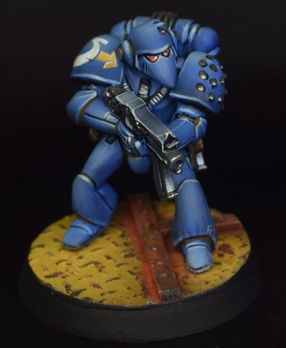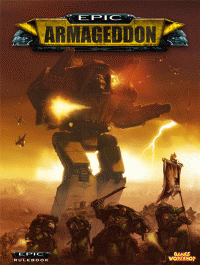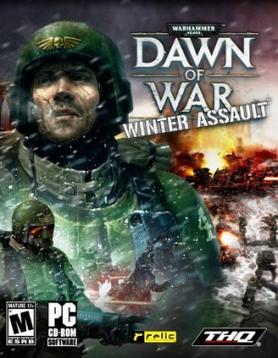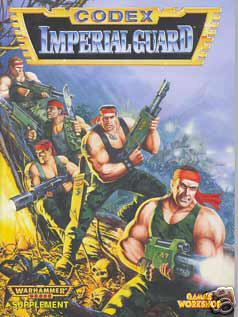Gameplay
History of the Imperial Guard as an army


The first edition of Warhammer 40,000 included rules for a force known as the "Army". Later their name was changed to "Imperial Guard" and then as of 7th edition "Astra Militarum". The Imperial Guard make up the backbone of the Imperium's armed forces.
The Imperial Guard was initially bound by a series of rules, published in the Warhammer 40,000 Compendium, relating to its command structure. Squads of units formed platoons under a command squad. Units that were separated from the command squad were more limited in action. The initial Imperial Guard army could include, besides the basic squads, Rough Riders (a form of Cavalry), penal units, human bombs, abhumans and robots. Several vehicles were available, including; motorcycles with an optional side-car, Jet cycles (a form of jet propelled motorbike), grav attack vehicles (armoured fighting vehicles utilising anti gravity for propulsion) and Sentinels (a two-legged walker, similar to an AT-ST),. [6]
The first incarnation of the Imperial Guard as a fully supported army was in 1995, with the release of the Codex: Imperial Guard sourcebook for the second edition of Warhammer 40,000. This was the first time that the army itself had specific army rules collected in their own sourcebook. [7] With the release of the third edition of the game, almost all the Warhammer 40,000 armies eventually had new codices compatible with the new edition. In line with this, Codex: Imperial Guard was released in 1999, [8] followed by Codex: Catachans in 2001. This was a smaller sourcebook (or mini-dex/mini-codex) that was meant to be used in conjunction with the "parent" Codex: Imperial Guard. The mini-dex itself provided even more specific rules for fielding one of the more popular Imperial Guard sub-armies, the Catachan Jungle Fighters, for which plastic models were available. [9] In 2003, Games Workshop conducted the Eye of Terror worldwide campaign and released a corresponding sourcebook, Codex: Eye of Terror. This campaign sourcebook contained various rules, including a specific army list for another one of the Imperial Guard's notable sub-armies, the Cadian Shock Troops. [10] Soon after the campaign ended, the changes in the Cadian Shock Troops army list were integrated into the Imperial Guard rules, and Games Workshop released a second, revamped version of Codex: Imperial Guard. [1]
In the actual in-universe background, the predecessors to the Imperial Guard was the Imperial Army alongside innumerable Imperial Cults and Militias present throughout the Great Crusade, but also more elite forces, such as the Solar Auxilia. However, after the Horus Heresy, the Imperial Army was split into the Imperial Guard and Navy to prevent either force from either having the ability to their gain quick access to transportation or field occupational troops quickly if any of their divisional units turned traitor.
Overview
Individual guardsmen are weak, thus Imperial Guard armies are usually rather large. In addition, they have access to various vehicles, such as the Leman Russ main battle tank, Basilisk mobile artillery, Manticore rocket artillery, Chimera armoured troop transport and the Sentinel walker. Because they require so many units, an Imperial Guard army can be expensive and time-consuming to assemble and paint. In regards to their weak infantry, when they don't vastly outnumber the enemy, the guardsmen rely on their unique tanks and fire support.
In a later Codex, the Imperial Guard "doctrines" were removed, replaced by the "orders" system. Units designated by the "order" must be in a specific distance radius from either a Platoon Officer or a HQ Officer. Benefits are given if both the officer's unit and the squad receiving the order have "vox-casters" (in-universe term for "radio").
In addition to baseline humans, the Imperial Guard also contains several types of abhumans — humans evolved from radically different planetary environment over tens of thousands of years that differ markedly from the norm. The two species most commonly found are the Ogryns (the counterpart of the Warhammer Fantasy setting ogres) whose superhuman strength and incredibly tough resilience makes them excellent close combat fighters and the Ratlings (resembling halflings/hobbits) who function as expert snipers and trackers.
One of the more distinctive aspects of the Imperial Guard army is its Commissars. They are represented as akin to the ruthless, political commissars of the former Soviet Union. The Imperial Commissar, as described by many Warhammer novelists, is given complete jurisdiction to judge the actions of any trooper or officer and to act accordingly. This includes up to summary execution of units who display disobedience or cowardice (in gameplay, this is an often useful function that boosts the morale of wavering units and prevents possessed psykers from harming their comrades) This is useful for the Imperium who must keep an ever-watchful eye in case their subjects turn to chaos. Understandably, they are much hated by the guardsmen they serve with. Many novels hint that a good portion of the Commissars slain in battle are "accidentally" hit by friendly fire; the 4th-Edition Codex for the notoriously anti-authoritarian Catachan regiments of the Imperial Guard includes the "Oops, Sorry Sir" rule that gives Commissar models included in a Catachan army a 1-in-6 chance of having been killed – or more appropriately, fragged – before the game begins. The Death Korps of Krieg are famous for killing Commissars/CO's should ever they commit cowardice themselves and attempt to flee. There are also hints that most if not all Commissars primarily inspire troops by heroic or suicidal example, hoping to emulate figures like the "heroic" Commissar Ciaphas Cain or Colonel-Commissar Ibram Gaunt.
Another unique aspect of the Imperial Guard is that the models for the regiments of different worlds are physically distinct, rather than the same models with different paint schemes like the other armies (save the Space Marines where the Blood Angels, Dark Angels, Space Wolves, and Grey Knights Chapters all have models specific to them which other Chapters may not field and as such are considered separate armies). For example, the models for the Cadian Shock Troops resemble the soldiers of the Mobile Infantry as seen in the movie Starship Troopers and the Catachan Jungle Fighters appear in the stripped down uniforms as worn by American and Australian soldiers during the Vietnam War, and as seen in movies such as Rambo – a look befitting the inhabitants of a jungle world where everything is trying to kill them.
As a single platoon contains several squads, and each squad has options for taking special and heavy weapons, a single troops choice can take a staggering amount of said weapons: a fully loaded platoon may take up to 11 special weapons and 20 heavy weapons in a single troops choice, while most other armies can only take one of each. This, combined with the heavy firepower of Guard vehicles, produces an army that is primarily geared toward firepower. To offset this and create a proper balance to the game, the designers made the average Imperial Guardsman both physically weaker and less skilled with their weapons. This means that should an enemy withstand the blistering hail of weapons fire and close the distance to assault the Guardsman in melee, the Guardsmen will more than likely be torn apart.
Some of the major strengths of the Imperial Guard army are their vehicles. From the fragile, but mobile Scout Sentinel to the devastatingly destructive Leman Russ Demolisher firing small nuclear weapons to the long ranged Basilisk self-propelled howitzer, the vehicles of the Imperial Guard can significantly add to their effectiveness as an army. Although individual tanks from other armies (such as the Necrons) may sport more firepower, speed, and/or armour than those of the Imperial Guard, the Guard has, overall, the most powerful and varied armoured force, with many devastatingly powerful units like the Baneblade Super heavy Tank and it's many variants, or the DeathStrike ICBM Launcher platform (armed with plasma warheads) being added to the possibilities.









